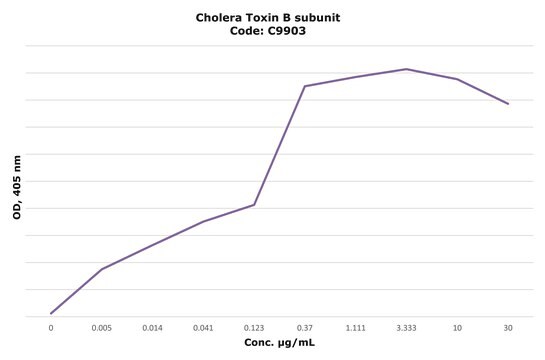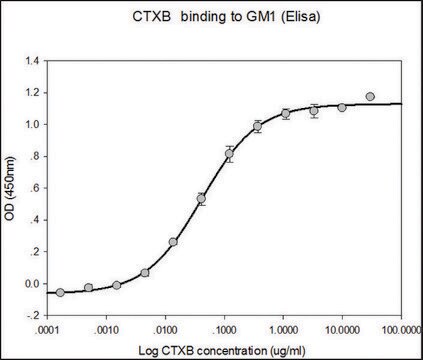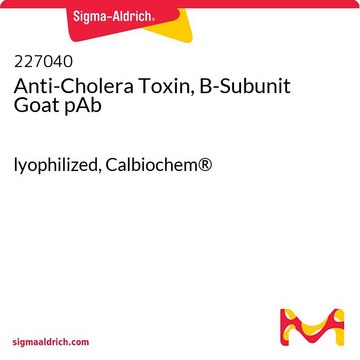C9972
Cholera Toxin B subunit
biotin conjugate, lyophilized powder
Sinonimo/i:
CTB
About This Item
Prodotti consigliati
Coniugato
biotin conjugate
Livello qualitativo
Forma fisica
lyophilized powder
PM
~12 kDa
Composizione
Protein, ~40% Lowry
Temperatura di conservazione
2-8°C
Stringa SMILE
CCOc1ccccc1C(=O)Nc2ccc(Cl)c(c2)C(F)(F)F
InChI
1S/C16H13ClF3NO2/c1-2-23-14-6-4-3-5-11(14)15(22)21-10-7-8-13(17)12(9-10)16(18,19)20/h3-9H,2H2,1H3,(H,21,22)
YDXZSNHARVUYNM-UHFFFAOYSA-N
Cerchi prodotti simili? Visita Guida al confronto tra prodotti
Descrizione generale
Applicazioni
- in immunofluorescence
- in the analysis of major histocompatibility complex (MHC) class II lipid raft partitioning
- in live cell three-dimensional tracking of SH-SY5Y human neuroblastoma cells
- to assess the toll-like receptors (TLR) and FcRγ (Fc receptor γ chain) – CARD9 (caspase recruitment domain family member 9) activation by cholera Toxin B (CTB)
Azioni biochim/fisiol
Qualità
Stato fisico
Risultati analitici
Indicazioni di pericolo
Consigli di prudenza
Classi di pericolo
Aquatic Chronic 3
Codice della classe di stoccaggio
11 - Combustible Solids
Classe di pericolosità dell'acqua (WGK)
WGK 3
Punto d’infiammabilità (°F)
Not applicable
Punto d’infiammabilità (°C)
Not applicable
Dispositivi di protezione individuale
Eyeshields, Gloves, type N95 (US)
Certificati d'analisi (COA)
Cerca il Certificati d'analisi (COA) digitando il numero di lotto/batch corrispondente. I numeri di lotto o di batch sono stampati sull'etichetta dei prodotti dopo la parola ‘Lotto’ o ‘Batch’.
Possiedi già questo prodotto?
I documenti relativi ai prodotti acquistati recentemente sono disponibili nell’Archivio dei documenti.
I clienti hanno visto anche
Il team dei nostri ricercatori vanta grande esperienza in tutte le aree della ricerca quali Life Science, scienza dei materiali, sintesi chimica, cromatografia, discipline analitiche, ecc..
Contatta l'Assistenza Tecnica.










